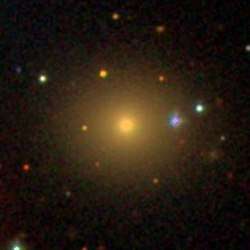NGC 1259
| NGC 1259 | |
|---|---|
 SDSS image of NGC 1259. | |
| Observation data (J2000 epoch) | |
| Constellation | Perseus |
| Right ascension | 03h 17m 17.3s[1] |
| Declination | 41° 23′ 08″[1] |
| Redshift | 0.019400[1] |
| Helio radial velocity | 5816 km/s[1] |
| Distance | 243 Mly (74.4 Mpc)[1] |
| Group or cluster | Perseus Cluster |
| Apparent magnitude (V) | 16[1] |
| Characteristics | |
| Type | S0[1] |
| Size | ~83,400 ly (25.58 kpc) (estimated)[1] |
| Apparent size (V) | 0.7 x 0.4[1] |
| Other designations | |
| MCG 7-7-46, PGC 12208[1] | |
NGC 1259 is a lenticular galaxy[2] located about 243 million light-years away[3] in the constellation Perseus.[4] The galaxy was discovered by astronomer Guillaume Bigourdan on October 21, 1884[5] and is a member of the Perseus Cluster.[6][5]
SN 2008L
A type Ia supernova designated as SN 2008L was discovered in NGC 1259 on January 14, 2008.[7][8][9]
See also
External links
- NGC 1259 on WikiSky: DSS2, SDSS, GALEX, IRAS, Hydrogen α, X-Ray, Astrophoto, Sky Map, Articles and images
References
- 1 2 3 4 5 6 7 8 9 10 "NASA/IPAC Extragalactic Database". Results for NGC 1259. Retrieved 2018-06-15.
- ↑ "Your NED Search Results". ned.ipac.caltech.edu. Retrieved 2018-06-15.
- ↑ "NED Query Results for NGC 1259". ned.ipac.caltech.edu. Retrieved 2018-06-15.
- ↑ "Revised NGC Data for NGC 1259". spider.seds.org. Retrieved 2018-06-15.
- 1 2 "New General Catalog Objects: NGC 1250 - 1299". cseligman.com. Retrieved 2018-06-15.
- ↑ Brunzendorf, J.; Meusinger, H. (October 1, 1999). "The galaxy cluster Abell 426 (Perseus). A catalogue of 660 galaxy positions, isophotal magnitudes and morphological types". Astronomy and Astrophysics Supplement Series. 139 (1): 141–161. doi:10.1051/aas:1999111. ISSN 0365-0138.
- ↑ "List of supernovae sorted by host name". Bright Supernova - Archives. Retrieved 2018-06-15.
- ↑ "2008L - The Open Supernova Catalog". sne.space. Retrieved 2018-06-15.
- ↑ "SN 2008L | Transient Name Server". wis-tns.weizmann.ac.il. Retrieved 2018-06-15.
This article is issued from
Wikipedia.
The text is licensed under Creative Commons - Attribution - Sharealike.
Additional terms may apply for the media files.